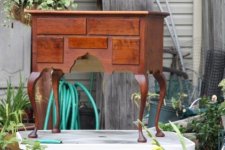I though I would try to create some conversation since it has been slow on the form. I built a dressing table from plans from one of Franklin Gottshalls books, after looking at it, I like the look of the legs but was wondering how much curve in the leg is possible before you start compromising the integrity of the leg? As you can see the legs are pretty light and dainty, am I going to have problems in my life time? Curious about your thoughts, thank you, John??PS Don?t make too much fun of my spray booth, Mama would have my ass if I sprayed Lacquer in the house.
You are using an out of date browser. It may not display this or other websites correctly.
You should upgrade or use an alternative browser.
You should upgrade or use an alternative browser.
Dressing table legs
- Thread starter jogrand
- Start date
rchampagne
Well-known member
John, its good to see a new post! Nice looking dressing table. I can't really comment on the strength of a severely curved leg, but the first thing that came to mind was that recent FWW article where they put various joints on a press to see how much force would be required to break them. I can say that when carving ball and claw feet on a pipe clamp I've noticed some flex in the leg at the ankle when tightening the leg up.
Rob
Rob
When I was taking a ball and claw class, a classmate accidentally cracked a leg by overclamping. It cracked right at the ankle. Made me very "aware!" A little epoxy and he was back in business.
I've always wondered about the limits myself. Especially when looking at a highboy and figuring somebody would be loading those drawers up. I wonder too if what we define as "good looking" leg is based on legs from the period and how much of that design was based on strength concerns vs. shape preferences? Interesting to think about.
I just built a tea table and it has some very long and slender legs. Of course the application is different since they shouldn't be loaded with too much weight in use. But what if the tea is Long Island Iced Tea and somebody leans or perhaps falls on the table? Then we have a problem!
Tony
I've always wondered about the limits myself. Especially when looking at a highboy and figuring somebody would be loading those drawers up. I wonder too if what we define as "good looking" leg is based on legs from the period and how much of that design was based on strength concerns vs. shape preferences? Interesting to think about.
I just built a tea table and it has some very long and slender legs. Of course the application is different since they shouldn't be loaded with too much weight in use. But what if the tea is Long Island Iced Tea and somebody leans or perhaps falls on the table? Then we have a problem!
Tony
Mark Arnold
Well-known member
John,
Some cabriole legs were fairly curvy like the bandy legs on Dunlap pieces, but I can't attest to their survivability relative to less daring legs. Broken legs were either repaired or scrapped.
You will find some really exagerrated cabrioles on Centennial pieces (see attached). I'm not sure why that is since they had originals to copy. Maybe they thought that more of a good thing is even better!
Some cabriole legs were fairly curvy like the bandy legs on Dunlap pieces, but I can't attest to their survivability relative to less daring legs. Broken legs were either repaired or scrapped.
You will find some really exagerrated cabrioles on Centennial pieces (see attached). I'm not sure why that is since they had originals to copy. Maybe they thought that more of a good thing is even better!
Attachments
Jeff L Headley
Well-known member
You should be able to draw a straight line from the center of the square at the knee to the center of the bottom pad and have meat on either side then sculpt to you're hearts content.
John McAlister
Well-known member
Jeff, that's a good rule of thumb, which I had never heard. Those "bandy" legs in the Dunlap piece that Mark pictured looks like the table is standing in a half knee bend! Makes me tired to look at! John McAlister
Share:


